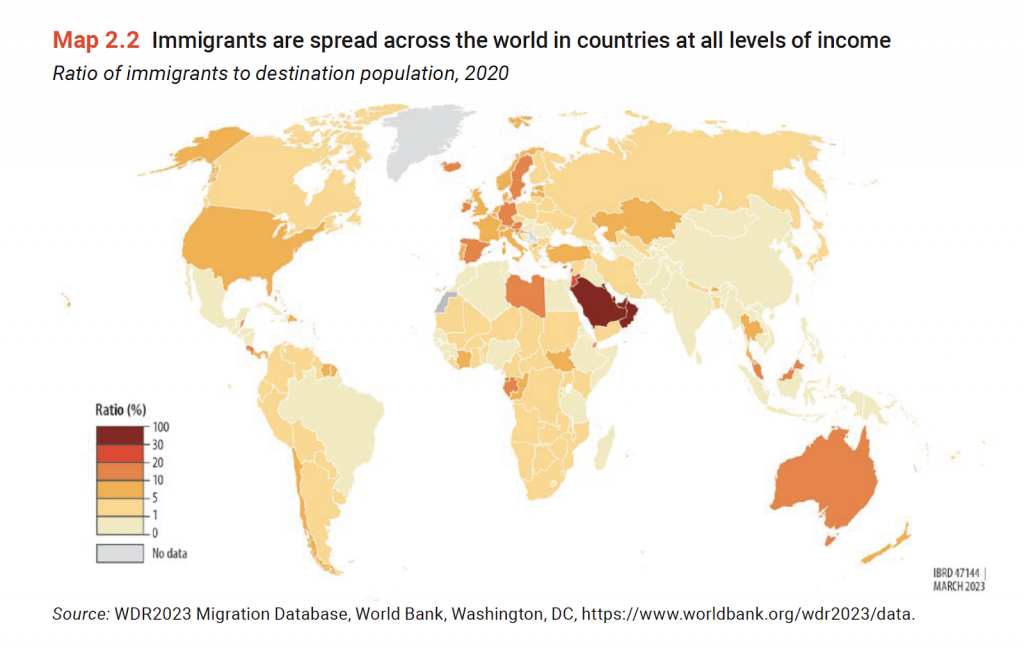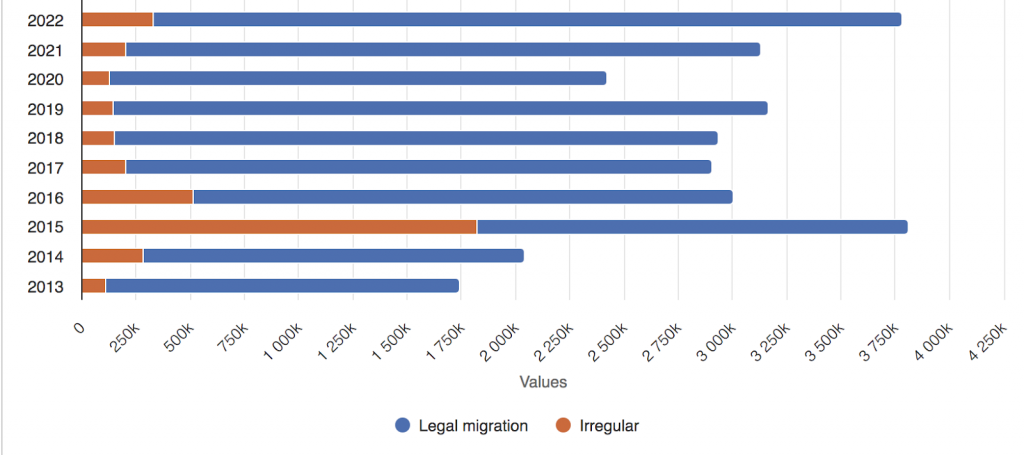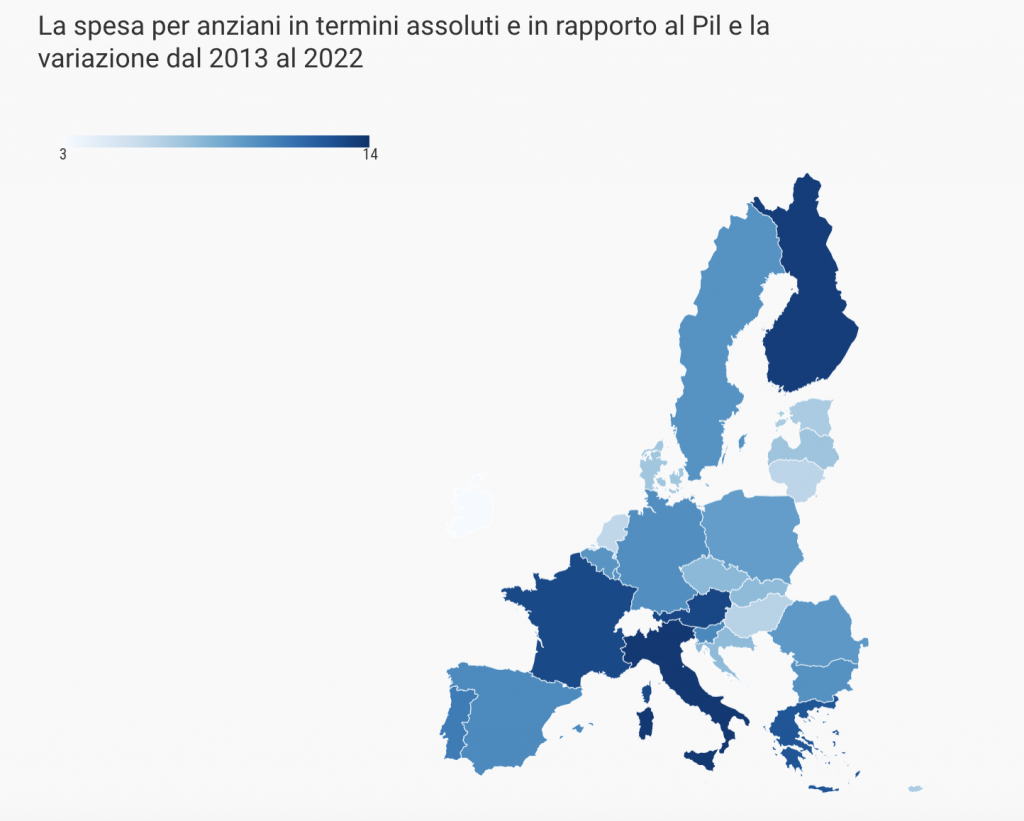https://www.valigiablu.it/unione-europea-migranti-accoglienza-bisogno/
- |
“The right advances”.“The European People's Party wins by a landslide”.“The real dark wave is yet to arrive.”These are some of the newspaper headlines that tell the outcome of the European elections on Saturday 8 and Sunday 9 June.The results were expected:the right and the far right increased their consensus, but did not obtain an absolute majority in the European Parliament.The three main right-wing parties (the more moderate European People's Party, the Conservatives and Reformists, which includes the Brothers of Italy, and Identity and Democracy, which includes the League) have different positions on many issues but they all agree on a point:the need to clamp down on migration in Europe, pushing towards an increasingly restrictive policy towards people arriving on the territory of the Union.“We want to stop uncontrolled migration,” was the slogan printed in large letters on the election posters of the European People's Party.
Already last April 10th the European Parliament voted for the adoption of the new Pact for Migration and Asylum, which establishes an even more security policy regarding reception.Just over a month later, on May 15, 15 European governments - including Italy - sent a joint letter to the European Commission and its head of Home Affairs, Ylva Johansson, to ask them to develop "new solutions to tackle irregular migration in Europe".The letter reads that “the current challenges relating to the EU asylum and migration system, including the sharp increase in irregular arrivals, are unsustainable” and that this “hinders our ability to provide better protection and livelihoods to a greater number of refugees".For this reason, the signatory governments ask the Commission to "identify, develop and propose new ways and solutions to prevent irregular migration in Europe".
Given these premises, it is interesting to ask ourselves some questions:What numbers are we talking about?Is Europe really at the top of the list of favorite destinations for migrants?And in the future will the European Union still be busy keeping people out, or will it perhaps have to worry about how to attract them?
What we talk about in this article:
An increasingly marginal Europe in global migratory flows
When we talk about migration, the trajectories we imagine have many starting points - sub-Saharan Africa, the Middle East, the Indian subcontinent - but only one point of arrival:Europe.However, we rarely think about all those people who, in search of a better life, leave their country to go to places other than Europe.But the data tells us clearly:the European Union is no longer the preferred destination for those who emigrate.
Currently, globally, according to the World Migration Report 2024 of the World Organization for Migration (IOM), just one in three migrants lives in Europe.The World Bank, in World development report 2023, highlights what the main migratory flows are today:from Mexico to the United States, from India to the United Arab Emirates and Saudi Arabia, from India and China to the United States, from Kazakhstan to Russia (and vice versa), from Bangladesh to India, from the Philippines to the United States .Europe isn't even mentioned.Other massive movements of people are linked to serious situations of forced displacement, due to wars and famines:there are movements from Syria to Türkiye, from Venezuela to Colombia, and from Ukraine to Poland.
In short, what emerges is that many migrants and refugees do not necessarily choose the European Union as a destination nor do they move to rich countries:to date only 40% emigrate to an OECD (Organization for Economic Co-operation and Development) country, while 43% go to low- and middle-income countries and 17% opt for one of the Gulf Cooperation Council countries (GCC).

These trajectories are also confirmed byAtlas of Migrations, created by the European Commission itself.Some emblematic data:in 2020, 40.6 million people emigrated from the African continent, of which only 23% came to Europe.The numbers are even more impressive when analyzing Asia:out of 111 million people who emigrated in 2020, just 8% chose Europe as their destination.
“There is no clear distinction between countries of origin and destination countries of migrants,” we read in the World Bank report.“Most countries are both, at the same time.”For example, the UK is home to around 3.5 million immigrants, but is also the origin of 4.7 million emigrants.Nigeria is home to nearly 1.3 million immigrants and is the place of departure for 1.7 million emigrants.Turkey has a large diaspora of economic migrants in Europe, but is also home to 3.5 million Syrian refugees and over 2 million internal migrants.“Every society needs a combination of policies to best address the situation of both people entering and leaving,” the report concludes.
The dimensions of irregular migration in Europe
During this campaign for the European elections, we have often heard about illegal entries, the fight against traffickers, smugglers and criminal organisations.Let's try to give a dimension to the phenomenon:How many irregular migrants are there in Europe?
“Although irregular immigration is often the focus of attention, in reality irregular entries represent only a small part of immigration into the EU,” writes the European Commission in an analysis of Eurostat data on migrants in Europe.In 2021, out of a total of 1 million 133 thousand people who immigrated to the European Union, only 200 thousand were irregular, just over 6%.The percentage was 5% in 2020 and 4% in 2019.It is also interesting to analyze the number of repatriations:in 2022, 431 thousand people were ordered to leave the Union.A 27% increase compared to 2021.

Regarding refugees, the Commission writes that “at the end of 2021, less than 10% of all refugees and only a small part of internally displaced persons were living in the EU.”The number increases significantly in 2022, due to the war in Ukraine:at the end of the year the percentage of asylum seekers in the Union exceeded 20%.The largest group is that of Syrians, followed by Afghans and Turks.A significant percentage of applicants come from visa-exempt countries:Ukraine, but also Venezuela, Colombia, Georgia and Albania.
The data shows that not all countries welcome:the majority of first asylum applications are presented in Germany, which alone reached almost 218 thousand in 2022.Followed by France (137 thousand), Spain (116 thousand) and Austria (110 thousand).Italy, on the other hand, barely received 77 thousand.
Small numbers, if you consider that in the world there are 110 million people who have been forced to leave their homes due to war, persecution, violence or violations of human rights. The data is reported by UNHCR, the United Nations refugee agency, and dates back to 2023:of these, more than 43 million are children.And 62 million are internally displaced, i.e. people who have chosen to emigrate within the same country.Here too it emerges that 75% of refugees are hosted in low- and middle-income countries.
An increasingly older Europe
Be careful, though:It is in high-income countries that migration could play an even more important role in counteracting a demographic decline that seems inexorable.The European Union is implementing a crackdown on reception policies, but paradoxically it may soon find itself in need of migrants, for various reasons.
In fact, thanks to the improvement of living conditions and the consequent lengthening of life expectancy, the number of elderly people is constantly increasing.At the same time, there is a decline in births:this is why in Europe, as in other regions of the north of the world, the population is increasingly ageing.
How it emerges from Eurostat demographic surveys, at the beginning of the 2000s in the European Union the percentage of people aged at least 65 out of the total was around 16%.Twenty years later the value increased by 5 percentage points:in 2023 the elderly will be 21.3%, more than 90 million people.This share varies widely from country to country:Italy and Portugal are in first place, both with 24% of the elderly population, followed by Bulgaria, Finland and Greece, with shares above 23%.
One of the most impactful consequences is the increase in public spending, in particular the costs of health systems, but also of specific services for the elderly.Expenditures for the elderly today equate to over 10% of European GDP: as Open Polis reports, Italy is the first country, with more than 266 billion euros and a spending on the elderly-GDP ratio of up to 13.7%.Meanwhile, there are fewer and fewer people of working age:the stability of the entire pension system is at risk.

For this reason, the immigration of young people and often with a greater propensity to have children can partly mitigate the decline of the population.According to always the World migration report 2024 of the IOM, the contribution of international migration in high-income countries led to a population growth of 80.5 million people between 2000 and 2020, effectively exceeding the negative balance between births and deaths (minus 66.2 million of people).“In the coming decades, migration will be the sole driver of population growth in high-income countries,” the report concludes.
Repel or attract migrants?
The problem is increasingly urgent, also because we will no longer be the only ones who need young people ready to work, who will allow us to keep state budgets and the pension system in balance.Let's think of China, a giant which, after decades of one-child policies, seems headed towards an irreversible demographic winter: data from the Chinese National Bureau of Statistics show that between 2022 and 2023 the population fell by 2 million people, and the United Nations estimates that China's population will decline by 109 million by 2050.The same goes for the United States, where the Census Bureau recorded an increase of more than a third of over 65s in the last decade, the fastest rate in the last 130 years:elderly people today make up 16.8% of the population, and their share will continue to increase as the baby boomer generation ages.Yet last June 4, President Joe Biden signed a decree to restrict arrivals at the border with Mexico.
The World migration report of the IOM shows that Europe and Asia are the continents that currently host the most international migrants in the world, with approximately 87 and 86 million people respectively (2020 data), equal to 61% of the total.North America follows, with almost 59 million migrants.However, Asia recorded the most significant growth from 2000 to 2020, at 74%.When compared to the population size of each region, the shares of international migrants in 2020 were highest in Oceania, North America and Europe, where they represented 22%, 16% and 12% of the total population, respectively:this is where the phenomenon has the greatest impact.
“In 2050, China and India will lead the ranking of the richest countries in the world, ahead of the United States and the European Union,” writes journalist Gabriele Del Grande in his essay The mobile century, where he analyzes the history of migration in Europe over the last hundred years.“Indonesia, Brazil and Mexico will sit with them at the G7 and the African Union will celebrate its third uninterrupted decade of economic boom.In the meantime, the inhabitants of the Earth will have risen from 8 billion today to almost 10, half thanks to the demographic explosion of the countries south of the Sahara in which, in the meantime, 1 billion more Africans will have been born.Nigeria alone will have 400 million citizens, as many as the entire EU.On the other hand, the European population, increasingly older and declining, will continue to decline until it represents only 5% of the world population.Humanity of the future, in fact, will live half in Asia and a quarter in Africa."
In short, in the world of tomorrow, Europe's demographic, economic and political weight will be decidedly reduced.And so in the future the European Union could no longer find itself with the problem of how to keep migrants out, but of how to attract enough of them.
Preview image Gariwo Street
